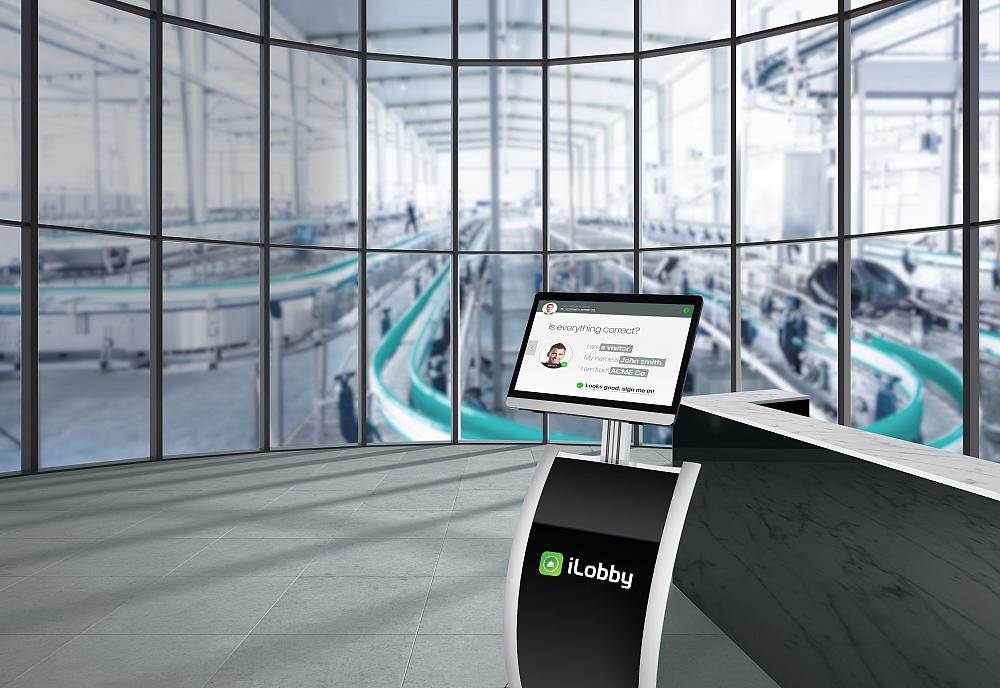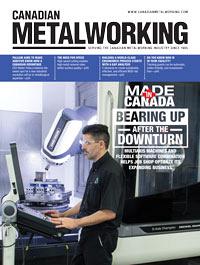- FMA
- The Fabricator
- FABTECH
- Canadian Metalworking
Do You Know Who Is In Your Facility?
Tracking guests can be automatic, visitor-friendly, and receptionist-free
- By Sue Roberts
- May 18, 2017
- Article
- Management
Developing, adhering to, maintaining, and reporting on manufacturing processes are critical to staying competitive. Providing traceability and accountability for every component passing through a shop; identifying raw material sources; and determining who, and what was involved with each step of production are expected. A variety of resources are available to help get the job done.
Securing a company’s knowledge, equipment, processes, facility, and employees requires similar steps. Yet a receptionist tasked with vetting each visitor at the main entrance—expected or a drop-in—is an investment fewer and fewer manufacturers are making.
A vestibule with a phone and list of numbers to be used to alert the desired person that an individual is waiting to be buzzed in is a visitor’s first experience in many companies. Or, a visitor may need to wait for an employee working in another area of the building to leave their task, come to the lobby, and act as an escort. Meantime, the guest most likely needs to enter specifics about the visit into a logbook. The logbook may simply be an attempt to monitor activity and verify an individual’s identity, or it may serve as a detailed record for facilities serving highly regulated industries.
Securing a Facility
INKAS® Group of Companies, known for providing security products for the transport of cash, goods, and people, has expanded its product line to include a system that monitors who is receiving access to a company. iLobby, a software system that integrates with a company’s platform, verifies that an individual making it past the front entrance is expected and welcome. The system also makes the guest registration process easy, fast, and receptionist-free, according to the company.
David Fraser, INKAS COO, explained how the software fits with the company’s product mix. “All eight of INKAS divisions secure something—assets, people, the environment. The company started as a cash and transit company then decided to build the vehicles that were used. So it went from providing security of assets to building vehicles to secure those assets. The next step was point-of-sales services, which is an extension of security. Then came building safes, which is basically an extension of the cash and transit vehicles, only without the wheels.
“AppGear is an IT company added to the roster. Its services started us thinking about other software-based opportunities in the realm of security. We saw that in Toronto manufacturing companies may have shipping and receiving departments, but there are not a lot of receptionists at front desks. That led to the development of the software-based visitor security system. We recognized an opportunity to help secure the main entrances to manufacturing facilities and assist companies in being compliant with various regulations and to save everyone time.”
Monitoring Guest Information

The software walks visitors through a series of questions before notifying the appropriate person to meet them in the lobby area.
iLobby Visitor Management System is a visitor registration and management system that can reside on a tablet at a company’s entrance. It replaces the sign-in book and frees up the receptionist. Visitors can be provided with a code and any needed preliminary paperwork, such as notification of any health or safety standards to be followed, and to allow for preapproval of the visit.
A visitor responds to a series of questions to verify their identity and purpose of their visit or scans the preissued QR code. iLobby notifies the appropriate employee through phone, SMS, email, or an iLobby app that has been downloaded to their smartphone. Notification can include an image of the guest for visual identification. The system can collect a signature for further verification and print a visitor’s badge.
Registration QR codes provided in advance of a visit can include meeting time, location, and details for expected visitors. A code can be assigned to a specific individual who is a frequent visitor to streamline the registration process and avoid the need to print another badge.
“When there is a drop-in visitor, the system can be programmed to notify an employee designated as a point of contact. That person can be in any location in the plant so they can do their normal job and deal with the front entrance only if there is an unexpected visitor,” said Fraser.
“Using the technology is an enhancement of how to use employees’ time. No one has to be at a front desk workstation.”
Tracking Visitor Access
Companies serving highly regulated industries, such as defence, are often required to provide detailed reports on who has had access to the facility. The iLobby system produces standard or custom reports detailing who has entered a facility, when, and why . The reports can be automatically generated or generated on demand to detail daily, monthly, or annual activity. “This helps with compliance for security standards like ITAR [International Traffic in Arms Regulations] and other government standards that include visitor management and audit reporting,” said Fraser.
“This is a flexible tool. There are all kinds of analytics that can go on behind the tablet that can be adapted to almost any company’s requirements.”
All visitor information and documentation is encrypted and stored in a secure cloud for as long as it is needed. Using the cloud reduces data storage costs and allows for fast information retrieval.

Companies that man a receptionist desk use the system to collect visitor information, generate reports, and allow the personnel to focus on other duties.
“The system fits into a company’s own architecture. All information is owned by the company. Depending on a company’s needs, the software can be loaded onto its own tablets, or we can provide tablets that can be built into free-standing kiosks.”
Improving Safety
An added benefit to using the system is safety for visitors.
Fraser explained, “When I have visitors, I send them a code that lets them come in when they arrive. They have the QR code in their phones and the system recognizes that they are in the facility. So while they are here I can send them a message from my iPad or desktop. If there was a fire or any kind of emergency situation, the message can go to staff and guests alike. We know who is in the building so we can direct them to a safe zone or hit an evacuation button and do a roll call.
“This started off with the idea of security for the company. It turned out that it makes the visitor’s experience better, saves manhours, and contributes to safety. Let the software and the machine do the work.”
Photos courtesy of INKAS Group of Companies.
INKAS Group of Companies, 855-545-6229, www.goilobby.com
About the Author

Sue Roberts
2135 Point Blvd
Elgin, IL 60123
815-227-8241
Sue Roberts, associate editor, contributes to both Canadian Metalworking and Canadian Fabricating & Welding. A metalworking industry veteran, she has contributed to marketing communications efforts and written B2B articles for the metal forming and fabricating, agriculture, food, financial, and regional tourism industries.
Roberts is a Northern Illinois University journalism graduate.
subscribe now


Keep up to date with the latest news, events, and technology for all things metal from our pair of monthly magazines written specifically for Canadian manufacturers!
Start Your Free Subscription- Trending Articles
Identifying the hallmarks of a modern CNC

Zoller to host 2024 Open House and Technology Days

Wheel line expanded to accommodate heavy-duty industries

Tooling for spot facing and counterboring is completely customizable

Collet chuck provides accuracy in small diameter cutting

- Industry Events
MME Winnipeg
- April 30, 2024
- Winnipeg, ON Canada
CTMA Economic Uncertainty: Helping You Navigate Windsor Seminar
- April 30, 2024
- Windsor, ON Canada
CTMA Economic Uncertainty: Helping You Navigate Kitchener Seminar
- May 2, 2024
- Kitchener, ON Canada
Automate 2024
- May 6 - 9, 2024
- Chicago, IL
ANCA Open House
- May 7 - 8, 2024
- Wixom, MI
















